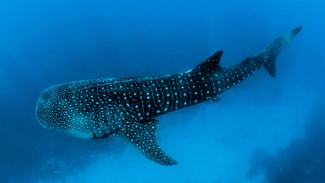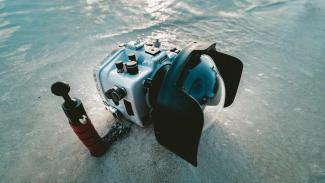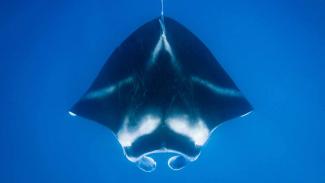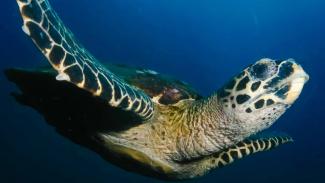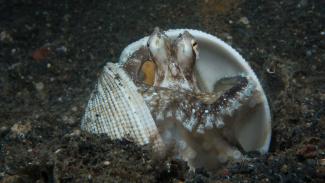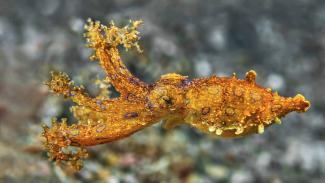
Dorothea Oldani
Just off the northern-eastern tip of Sulawesi, between Bunaken & Lembeh, lies the islands of Bangka & Sangihe.
These volcanic islands are less renowned for diving than Lembeh or Bunaken nearby, but are equally fascinating.
The volcanic nature of the area has led to some very unusual dive sites, including the chance to dive an active volcano and a dive site in a sunken village.
Highlights
Best diving spots
The main island in the area is Bangka Island, where the lush tropical rainforest appears to plunge straight down into the sea. Just off from this island, numerous pinnacles break the surface or lurk just beneath, providing fantastic diving opportunities.
Currents here can be quite strong, but the flow of nutrients results in stunning soft corals and bountiful marine life. Schools of Batfish & Barracuda hover mid-water, glinting in the sunlight, while Trevally & Tuna cruise the blue. Back on the reef, cracks & crevices hide plenty of critters and many species reef-fish are abundant. Large Napoleon Wrasse can also be seen here.
North-west of Bangka Island lies Palau Telisei, another site with majestic soft coral gardens to enjoy. Banded Sea Kraits are numerous here and there is a large cavern to explore if you have a good guide. Napoleon Wrasse often come for a closer look at divers. Nearby, Lihaga Island is great for critter lovers, with Leaf Scorpionfish, Ribon Eels & Pygmy Seahorses.
The star of the Bangka area is probably the Bangak Strait though. This area has been studied by scientists extensively as it is a migratory route for no less than nine species of Whale, including three different species of Sperm Whale, Melon-head Whales, Pilot Whales & Killer Whales. Dolphins use this route too and Manta Rays are commonly seen. The Whales pass through this strait in March & April and again in August & September. It is not always possible to dive here due to currents and the Whales tend to stay well away from noisy divers, but just witnessing these gentle giants from the boat is an experience to remember.
Running north-east from the tip of Sulwesi is the Sangihe Archipleago. These seldom visited, current swept islands offer some of the world’s most unusual diving. Mahengetang is a submerged, active, volcano. Gases bubble out of the volcano and everything is tinged with yellow - a result of the sulphurous deposits from the volcano. Marine life here, which is plentiful, mysteriously seems to be larger than anywhere else.
In case Mahengetang isn’t unusual enough for you, there is also a drowned village that you can dive in the area. The rumour goes that the village was engulfed by the sea during a huge volcanic explosion in 1963. Lying at around 25m in depth on a silty bottom, you can swim along manmade passages & tunnels, through doorways & other manmade structures now adorned with many black corals.
Ruang Island has Sangihe's best diving. A barren lava flow on the south side of the island stretches into the sea, where it transforms into a majestic coral reef. The reef is home to incredible diversity and numbers of marine life in every colour & hue imaginable. Sharks are commonly seen here, as are large Groupers, Tuna & huge schools of Barracuda. Needle Point and Para Island have more great diving, with large underwater pinnacles attracting all manner of life.
When to dive
This region can be dived all year, but offers the best diving conditions between March & October.
Getting there
Manado has an airport with flights to Makassar in the south of Sulawesi and also Bali, Jakarta, Surabaya & Balikpapan. There are now a few international flights aswell, linking Manado to Singapore, Malaysia & the Philippines.
Activities
As well as many accommodation options, Mandado has plenty to do when you are not diving. Options include shopping & golf, trekking in the surrounding countryside, visiting volcanoes and immersing yourself in the history & culture of the area.
Resort and liveaboard options
The region is quite limited in terms of accommodation currently, with a small number of dive resorts to choose from, and occasional liveaboard options.
You might also enjoy...
Southern Leyte
Southern Leyte may not be as famous as some of the Philippine's more celebrated diving spots, but don't let that fool you.
Leyte is the most easterly island of the Visayas region, and the island is also the least developed. It boasts exceptional scuba diving.
Currently, diving here is concentrated in Southern Leyte, which is gaining a reputation as one of the best places in the Philippines to see Whale Sharks.
Setting up your underwater housing
Have you recently purchased an underwater housing for your camera? Maybe you feeling a little unsure how to set-up your new system correctly and are feeling in need of some tips and advice.
Don't despair. No matter what brand your housing, whether it is a simple own-brand housing or a state-of-the-art set-up, there are steps you can take every time you take your camera into the water to ensure that it is set-up correctly.
Apo Reef
Lying off the west coast of the Philippines island of Mindoro Island is Apo Reef, a huge coral reef system. This reef is in fact the second largest single coral reef in the world.
The geography of the reef has created two internal lagoons, with spectacular plunging walls around the outside, comprising a total area of 34sq km.
Underwater housing care
Jakob Owens


